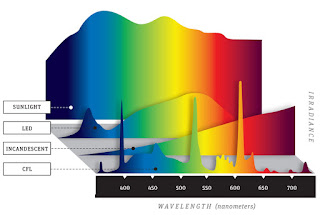Human have circadian rhythms that guide their daily routine, and sunlight plays an important role in regulating them. Dark and windowless rooms can have an adverse effect on health, as can artificial lights that do not accurately replicate natural light. Most lights used in buildings are fluorescent and have erratic emission spectra with spikes in wavelengths due to the emission spectra of the individual gasses used in the bulbs. This is unlike natural sunlight, which has a smooth emission spectrum curve that shifts over the course of the day. This lack of natural light can lead to eye fatigue, sleep problems, and an overall disruption of circadian rhythms. LED lights have much smoother spectrum curves that mimic natural sunlight more accurately.
 |
| Light Spectra of Different Light Sources |
 |
| The trial schedule we based our lighting code on. |
The goal of this project is to create an illuminated “window” that simulates daylight in a room without windows or access to natural light. This goal will be accomplished with the use of LED lights, which have variable red, blue, and green (RGB) values and emit light smoothly across the visual spectrum without sharp peaks. The color of the LEDs can be changed over the course of the day to match the emission spectrum of daylight.
 |
| Our LEDs changing color with sample code. |
The window itself is made from a 2'-by-2' sheet of diffusing plastic with a frame made of wooden 2-by-4s, along with a sheet of wood on the back of the frame. The LEDs are placed along the inside edge of the frame. The back panel of the window is coated in a highly reflective material to ensure that the light is effectively transmitted and spread throughout the entirety of the window.
 |
| The main body of our window. |
The control of the LEDs is be performed by script run on an Arduino Uno, written in the Arduino C/C++ based language using the Arduino IDE. The Arduino, along with a Real Time Clock unit (RTC), keeps track of the time of day and outputs a varying voltage to the LEDs. The voltage controls the RGB values of the light and allows it to match the color temperature of sunlight throughout the day.
 |
| The inside of the window, showing the Arduino wired to the LEDs on the inside frame. |
Our completed window is a self-contained source of light that can match a person's daily schedule, replicate the color temperature of daylight, and keep circadian rhythms steady.
Our finalized window in action.
Good! When you get farther along, be sure to add an image of your design. I'll be giving you a lens made by ULED - be sure to research what kind of lens it is and what its light distribution properties are. Be sure to credit the sources of your images, like the one above. Where'd you get it?
ReplyDeleteThe Project Proposal should also be included as its own tab.
ReplyDeleteWhat software is used to run Arduino?
ReplyDelete